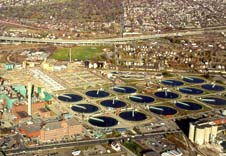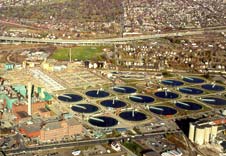
The Future Is Water Collaboration
Detroit, Mich., meets the suburbs in the middle
- By George Ellenwood
- Jun 17, 2008
 Detroit is known as the Motor City, but water may be its most vital resource. Detroit’s decision in the 1950s to build large water mains in the suburbs and connect them to its water plants pumped the economic and population growth of southeastern Michigan. Detroit’s water allowed the automotive industry to decentralize its factories and offices, and in the process, increased total population from 3.5 million in 1950 to almost 5 million in 2000.
Detroit is known as the Motor City, but water may be its most vital resource. Detroit’s decision in the 1950s to build large water mains in the suburbs and connect them to its water plants pumped the economic and population growth of southeastern Michigan. Detroit’s water allowed the automotive industry to decentralize its factories and offices, and in the process, increased total population from 3.5 million in 1950 to almost 5 million in 2000.
The region’s vast water system is owned and managed by the Detroit Water and Sewerage Department (DWSD). It is the nation’s third largest, supplying water and sewer services to the city's residential, commercial, and industrial customers as well as water services to 125 suburban communities. The water service area covers over 1,000 square miles.
Three intakes draw water from the Detroit River and Lake Huron and supply raw water to five water treatment plants. These plants distribute water through 3,400 miles of water pipes using 22 pumping stations and 17 reservoirs, all designed to deliver adequate pressure to 4 million customers from the middle of the winter to the hottest summer afternoon.
In 1999, DWSD launched a master planning effort, anticipating that capital improvements and infrastructure rehabilitation investment would be needed over a 50-year period. Such an extensive planning process had to involve its suburban customer communities, and DWSD invited them into the process.
The master plan, completed in 2003, called for $8 billion in capital investment and set the stage for a robust partnership between suburban communities and DWSD. In April of that year, DWSD and more than 30 elected officials, water system operators, consultants, and state regulators developed and signed a partnering agreement to work together as the Technical Advisory Committee (TAC).
TAC pledged to work as a team to provide a safe, secure, and reliable potable water supply with sufficient quantities and in an efficient and cost-effective manner. It identified several challenges for the partnership:
*lack of customer knowledge about the rate formula,
*concern about escalating water rates,
*suburban perceptions that the rate model was unfair,
*regional responses to water emergencies,
*pressure fluctuations in the summer, and
*a standard water contract for all suburban communities.
This partnering effort was the first in the department’s 170-year history and was a bellwether milestone, because it formalized the relationship between DWSD and suburban communities.
Like many regions across the country, a history of conflict exists between the central city (Detroit) and surrounding suburbs. Detroit was the midwife for suburban growth, but as the suburbs gained more economic and political power, they naturally wanted a stronger voice in decisions involving their water utility. Even though three suburban community representatives sit on the DWSD Board of Water Commissioners, some suburban leaders wanted direct control and, over the years, launched a series of takeover bills in the state legislature. Although these efforts came to naught, they certainly influenced DWSD's decision to extend its hand as a collaborative partner.
The TAC vision of collaboration is broad: all parties are asked to respect individual community and DWSD concerns and needs while looking at the system holistically. In other words, people promised to think locally but act regionally, at least as much as they were able given local politics.
DWSD hired professional facilitators to ensure communication and information sharing. Then the committee formed workgroups to tackle rates, contracts, emergency preparedness, and customer service challenges. DWSD and suburban community representatives served on the workgroups and the facilitators helped the workgroups stay on point, develop consensus, and dampen the passions that had stirred the region for decades. The facilitators also established a group scheduling and document storage system that is used by more than 300 people.
Currently, more than half of DWSD’s suburban communities participate on the committee, and TAC hopes to expand participation to all of the suburban communities. In 2008, meeting attendance has surpassed 100 participants.
One of TAC’s signal achievements has been the creation of a new model water contract. In 2003, more than 50 percent of the contracts with suburban communities had expired. Thanks to TAC collaboration, 10 new water contracts have been negotiated with a plan to complete 50 more within the next 18 months.
The new model serves as a template for negotiating new contracts between DWSD and suburban communities. It not only institutionalizes TAC and its workgroups, but for the first time, the model contract provides DWSD pressure commitments to suburban communities. In return, the communities commit to limit their peak usage for a multi-year period. The result? Reduced rate volatility and vastly improved system planning.
Cooperation and dialogue have been effective tools in mapping out predictable relations between DWSD and its 86 direct contract wholesale water customer communities in Southeast Michigan and has prepared the region for the 21st century.
For more information about the Detroit Water and Sewerage Department, visit www.dwsd.org.
About the Author
George Ellenwood is the assistant director of the Public Affairs Group, consisting of the Commercial Operations, Meter Operations, and Public Affairs divisions. He serves on the Public Affairs Council of the American Water Works Association (AWWA) and the Research Advisory Council of the AWWA Research Foundation.